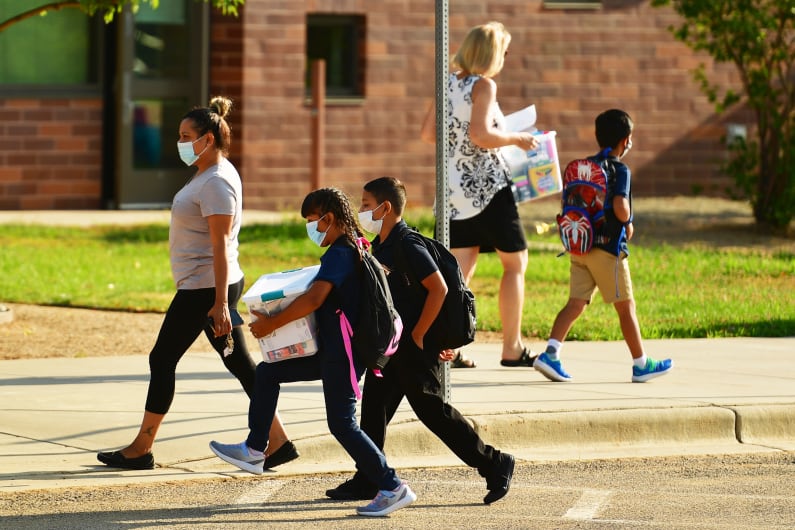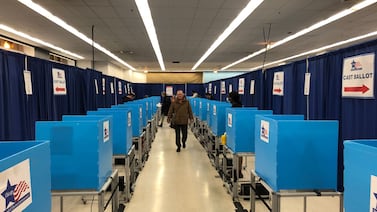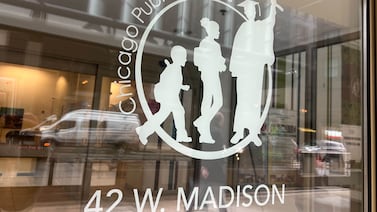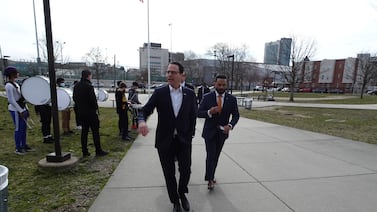As more Colorado school districts move some or all of their students to online learning, state public health officials issued a new report that stresses the benefits and safety of holding school in-person but offers scant new guidance or protocols to make that feasible.
Titled “In-Person Learning in the Time of COVID-19,” the report says that Colorado schools are “reasonably safe,” especially for students in kindergarten through eighth grade, and that schools have successfully used mask-wearing and cohorts to limit the spread of COVID-19 within school buildings.
The document underscores the benefits of in-person schooling, noting that families with limited resources often have a harder time supporting remote learning, meaning those students lose out on more educational opportunities and risk lifelong impacts.
In a press release, the Colorado Department of Public Health and Environment said the report aims to help schools make decisions about whether to stay in-person as cases rise. But the only guidance it contains are suggestions to cancel extracurricular activities and sports and pay close attention to cohort size when case rates are high. This comes after the state reversed itself to allow high school football to go on.
Education leaders said the report doesn’t address the primary challenges facing schools in the pandemic.
Bret Miles, head of the Colorado Association of School Executives, which represents superintendents, said his members don’t need to be persuaded of the benefits of school or even of the relative safety of school buildings. In many cases, districts and individual schools are switching to remote learning because after complying with state quarantine rules, they lack enough adults to run the building.
“There is not one state superintendent that doesn’t want to be open, that doesn’t understand their role in taking care of kids and ensuring the rest of the community can go to work,” Miles said. “The whole tone of the report about the importance of schools is one that superintendents agree with. Absolutely.
“But the rules create the circumstances in which we operate.”
Cases of COVID-19 have risen dramatically in Colorado throughout the fall. The state is reporting an average 3,400 new cases a day, up from around 800 a month ago, and test positivity is above 11%, a sign of both inadequate testing and high rates of community transmission. Twenty-five of the state’s 64 counties are in Level 3, the second-highest level of safety restrictions, with many at risk of going into the highest level.
Colorado’s school quarantine rules require that students and staff members who have been exposed to someone who tests positive stay home for 14 days in most circumstances. When COVID rates were lower, districts were allowed to take a more targeted approach to determining who should be considered a close contact. With the move to Level 3, entire classrooms have to quarantine. This has meant that districts are quarantining groups more often, because overall rates are higher, and more people have to go home with each quarantine.
Coupled with a widespread shortage of substitute teachers, many districts have found it increasingly difficult to maintain operations. Numerous school leaders have cited this challenge as they announced moves to remote learning for some or all students.
The report does not suggest any changes to the quarantine rules or any solution to staffing challenges, though it does encourage schools to change schedules so that fewer people have contact with each other.
Since school started in August, there have been 94 confirmed COVID outbreaks among more than 2,300 public and private schools in the state, the report says. An outbreak is defined as two or more cases occurring in the same place within a two-week period. Public health officials worry about the possibility of transmission in those circumstances. The report says there have been 308 confirmed cases associated with those outbreaks. That number doesn’t include incidents in which a single student or staff member tests positive with no other linked cases.
Outbreaks at schools have increased during the fall semester. Educational settings, including child care, now account for the largest share of outbreaks, with the majority of those occurring in child care centers, which have seen an even more dramatic increase. However, outbreaks in schools and day cares usually represent a handful of positive cases, compared with settings like jails, nursing homes, and meatpacking plants in which dozens or even hundreds of people have gotten sick.
Gov. Jared Polis recently declared schools to be “critical businesses,” meaning they can remain open even if their counties go to “Stay At Home.” Under Colorado’s system of local control, school districts ultimately make their own decisions.
At the same time, the report notes that “high transmission rates in the community have implications for transmission rates and levels of safety in schools not yet fully understood.”
High schools account for the largest share of outbreaks and cases at schools. The report urges districts to keep younger students in school even if high school students are home learning online. Districts should also prioritize in-person learning for students with disabilities who need specialized services, homeless students, and others who experience more challenges with remote learning, the report says.
School districts should also consider canceling extracurricular activities.
“While extracurricular activities have value for participants, they should not be prioritized at the expense of in-person learning, the health of school community members, and transmission of COVID-19 in the wider Colorado community,” the report says.
Amie Baca-Oehlert, president of the Colorado Education Association, the state’s largest teachers union, said the report does not grapple with the “extreme challenges” schools are facing as COVID numbers rise. The teachers union continues to advocate for clear and consistent metrics that would guide decisions about being remote or in-person.
Baca-Oehlert also signed onto a letter with Colorado pediatricians urging Polis to restrict other activities with higher risk of transmission to bring numbers down so that schools have a better shot at remaining in-person. In recent weeks, the governor has been reluctant to put new restrictions in place and has emphasized personal responsibility.
“The schools alone are not going to be able to manage and do this on our own,” Baca-Oehlert said. “It’s going to take the entire community.”







